Officer Mullen reports…
Earlier this week a groundskeeper at a golf course called our dispatch with concern for a Great Horned Owl that appeared to be situated in front of one of the equipment sheds. The owl had been on the ground for quite some time and there was a large group of crows circling above, dive-bombing and harassing the owl. I arrived at the golf course and the person who called me met me at the service road and directed me to where the owl was. Another gentleman was standing guard and protecting the owl from the relentless crows. Great Horned Owls often hunt and kill crows, so as soon as an owl is on the ground the crows take advantage and form large groups to continually harass their predator. The owl was sitting between two service sheds. Not wanting him to get scared and go between the sheds, I approached him from the side, talked softly to him and told him what I was about to do. Wearing bite gloves and using a long net I slowly got closer to the owl. The owl did resist a little and took a short flight, indicating that his wings worked properly, but quickly landed. He was then secured with the net, placed in a wire transfer cage and covered with a towel to reduce stress. Before fully covering him, I took a quick look at the owl to try and determine what was wrong. I immediately saw that one of the owl’s toes was bleeding and affecting the placement, curling the talon under the toe. I took a picture of the injury and texted our partners at Peninsula Humane Society & SPCA Wildlife Care Center in Burlingame. They said that they would gladly accept this Great Horned Owl for rehabilitation and treatment of his injury.
Great Horned Owls have large eyes and pupils that open widely in the dark for excellent night vision. Their eyes do not move in their sockets but they can swivel their heads 270 degrees to look in any direction. Great Horned Owls do not migrate and actively defend their territories that range in sizes of 0.1 to 1.5 square miles. These species mate for life and will return to the same partner every year for breeding. However once breeding and nesting season is over, the mated pair will separate and live solitary until the next season begins. Great Horned Owls have soft feathers to help insulate from the cold and also stifle the sounds of their wings making them almost silent when they are flying and hunting. These owls have the most diverse diet of all North American raptors ranging from small mammals, amphibians and insects to larger mammals such as skunk, rabbits, opossums and even porcupines.
We are very thankful for the person who notified and directed me to the injured owl and for the other bystander who stood guard protecting the owl from the harassment of the crows. They also helped me to document the process by taking photos and video. We were able to successfully transfer this owl to PHS Wildlife Care Center and are hopeful that once the bird heals, he will return back to his San Francisco home. If you see any injured wildlife, please call our dispatch at tel:415-554-9400, we have officers answering the phones from 6am to midnight 7 days a week. Interested in helping injured wildlife? We are always in need of drivers to help bring these animals to our transfer partners, please look at our volunteer page on our website and see how you can get involved (and see some pretty amazing wildlife, too).




